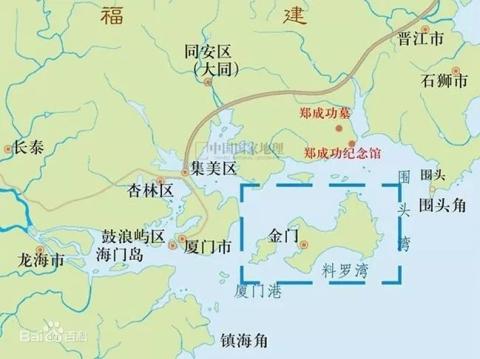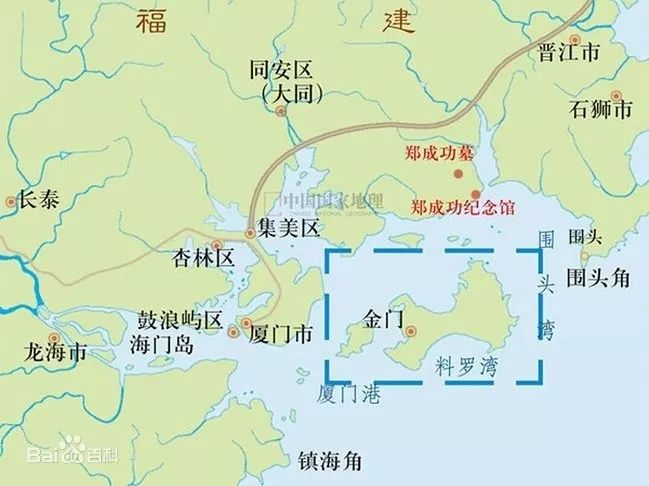
When I came back from the National Day, I really wanted to write about my experience of traveling to Kinmen, but due to many reasons, I didn’t have time to write. This Spring Festival holiday was extended due to the epidemic, so I just wanted to write about my feelings about going to Kinmen. But after such a long time, there may be some differences.
When talking about Kinmen, I have to talk about a piece of history and General Hu Lian. For the history of Kinmen, they are very important components (I use the history of mainland China, the history of Taiwan and mainland China are inconsistent). The first time I had an impression of Kinmen was at the Battle of Kinmen (called the Battle of Guningtou in Taiwan). Kinmen was an important island in the war against Taiwan at the time, but the 29th Army under General Ye Fei at that time did not understand the war situation at that time, and the army at that time did not understand naval warfare, which led to the final failure.

(Picture; from Baidu Encyclopedia)
The attack on Kinmen was launched on October 25, 1949, and the 29th Army of the People's Liberation Army was defeated on the 28th. Since then, there have been conflicts between Kinmen and the mainland.
In this war, in addition to not understanding it during the war, there was also the fact that the people employed were not on the same level. Here on the mainland, General Ye Fei is used, while in Kinmen, General Hu Lian is used. If General Ye Fei is a talent, then it is not an exaggeration to say that General Hu Lian is a genius.
General Hu Lian is a genius, even though he is a general of the Kuomintang. Mainland China commented on him: "General Hu Lian has the fighting spirit of General Zhang Lingfu, but does not have the arrogance of General Zhang Lingfu; his loyalty to the Kuomintang army is comparable to that of Huang Baitao, but his strategy is far superior to Huang Baitao's.”
At that time, I asked the locals in Kinmen what they thought of General Hu Lian. They said to me, "General Hu Lian is the 'benefactor of Kinmen'. He not only defended Kinmen locally. He also built roads, planted trees, and built schools. It can be said that many things in Kinmen now are attributed to Hu Lian." It was left over from the time when he was a general. "The current Kinmen specialty "Kinmen Sorghum Liquor" was created by General Hu Lian at that time to solve the economic problems at that time.

When we traveled to Kinmen this time, there were many places with the shadow of General Hu Lian. He was so important to Kinmen.
The first stop of our trip to Kinmen is the Ju Guang Tower. The Ju Guang Tower seems to be a place dedicated to commemorating General Hu Lian. For those who like humanities and history. This is a good place. Juguang Tower looks no different from an ordinary building from the outside. It is nothing more than bricks or the form of ancient buildings.

When I checked the information of Juguang Tower, I found that it was established by General Hu Lian. It also contains a lot of information about General Hu Lian's belongings and deeds during his lifetime, as well as some local cultural information from the past. Since I didn’t take any photos inside at that time, I forgot many places here. I remember there were three floors above it. The rest leaves me with the impression that nothing is big.
After I visited Juguang Tower, the taxi driver took us to a coastline. This coastline was left over from the war between the Kuomintang and the Communist Party at that time. On the outside is a row of past tanks, and on the inside are several tunnels. We walked around there a few times. But this place is very small.

The next few places we visited were all related to the Kinmen War at that time. Such as Chenggong Avenue, Guningtou Memorial Hall, Sun Yat-sen Memorial Forest, etc. Kinmen preserves the weapons and materials of the Kuomintang at that time. This is a great place to visit for people like me who love history. Since we only applied for a three-day visa at that time, we only had three days to play before going back.
This driver took us around for three days, and we chatted with him on the way. The driver was a middle-aged woman named Huang, who was very nice. The locals called her "Sister Huang". After I returned to the mainland, she often sent me holiday greetings.
I asked her in the car: "What do you think of us mainlanders?" She told me that she had a daughter studying for graduate school in Beijing. She said that you were too backward in the past, but she didn't expect that you have developed so fast in just a dozen years. We can't keep up with you. I asked her at the time, was it because we have a large population? She told me it wasn't just for this reason. Later she took us to a radio station at that time.
According to Sister Huang, this happened after the conflict between the two sides of the Taiwan Strait in 1949. It was established by the National Army and spoke to the People's Liberation Army. There were originally dozens of such broadcasts. Later, after the two sides of the Taiwan Strait started the three-way link, such broadcasts were constantly removed. Now there is only one left for tourists to visit. This radio broadcast was the voice of a famous Taiwanese singer, Zheng Lijun. When we passed by, the radio was talking about the Three People's Principles, and after he finished speaking, he sang. At that time, I wondered whether the reason why Teresa Teng was banned for so long in mainland China had something to do with this, rather than the conservative thinking at the time.

(Teresa Teng Radio and Television Station)
After visiting the local area, I went to a town to eat. I have learned about Taiwanese food here in mainland China, and it is very famous. However, the food we ate there seemed to be basically the same as in Xiamen, but the names were different. I don’t know if it’s because Kinmen is relatively close to Xiamen.
Most of what we went to eat at that time was in Jinsha Town, which retains many buildings from the past. Because I majored in design, I have a sensitivity to architecture and design. On the first day I came here, I felt that the architecture here had a Japanese style. Later, when I chatted with the driver, I said that because Kinmen is open, it will Learn from many people’s styles. Nowadays, Japanese design can be said to be the best design in the world, so many designs in Taiwan are learned from Japan. In addition, Taiwan has been studying Japanese culture for a while, and Kinmen has preserved its past culture and architecture very well, so you will see a lot of Japanese design styles.

(Jinsha Town)
We also visited here in the evening. The dusk lights here and the shop sign are very beautiful. The setting sun is completely above the shop sign. The shop sign is glowing yellow. It's very beautiful when you walk over and look at it. Quiet, like we are in a painting. However, my photo disappeared at that time. If any friends who go to Kinmen suggest that they must visit Jinsha Town in the evening.
Moreover, there are many places in Jinsha Town that are worth visiting, such as Model Street, Wujiang Academy, and Qiu Lianggong’s Mother’s Day memorial plaque, all of which are probably located in this location. There are many places here where a local will introduce them to tourists at night. For those who are visiting Kinmen for the first time, you can first listen to his introduction about Kinmen. Many places will be played more clearly later.
After we finished eating, we went back to where we were staying. We were staying in a B&B in Shuitou Village. This is also a place you can visit in Kinmen.
